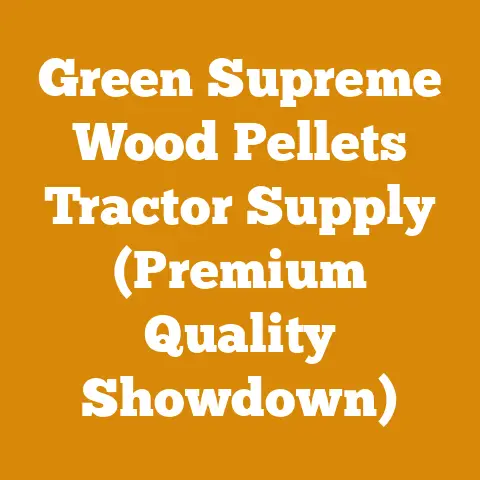Cooking on Wood Burner (5 Essential Tips for Perfect Firewood Flavor)
The warmth radiating from a wood stove isn’t just about the heat; it’s about the feeling. It’s the crackling symphony, the hypnotic dance of the flames, and, most importantly for the culinary adventurer, the unique flavor imparted to food. I’ve spent years felling trees, splitting wood, and tending fires, not just for heat, but for the distinct taste that only wood-fired cooking can achieve. It’s a journey of understanding wood, fire, and flavor, and I’m excited to share my insights to help you master the art of cooking on a wood burner.
Cooking on a Wood Burner: 5 Essential Tips for Perfect Firewood Flavor
Cooking on a wood burner is more than just throwing a pan on top. It’s a delicate dance of heat control, wood selection, and understanding how the flavor compounds released during combustion interact with your food. The aim here is to help you navigate this process, ensuring you get the best results possible and avoid common pitfalls.
1. The Right Wood: Fueling Flavor
Wood isn’t just wood. The type of wood you use dramatically impacts the flavor profile of your food. Think of it like wine – each varietal has its own distinct characteristics.
Hardwood vs. Softwood: The Fundamental Difference
The primary distinction is between hardwoods and softwoods. Hardwoods, like oak, maple, hickory, and fruitwoods (apple, cherry, pecan), are generally denser and burn hotter and longer. They also impart more complex and nuanced flavors. Softwoods, such as pine, fir, and cedar, burn quickly, produce a lot of smoke, and can impart a resinous or turpentine-like flavor, which is generally undesirable for cooking.
- Hardwoods: Ideal for sustained cooking and imparting distinct flavors.
- Softwoods: Generally unsuitable for cooking due to their resinous flavors and fast burn rate.
Flavor Profiles of Common Firewood
Here’s a breakdown of some popular cooking woods and their flavor characteristics:
- Oak: A classic choice, providing a strong, smoky flavor. It’s versatile and pairs well with beef, pork, and game.
- Maple: Offers a sweeter, milder smoke flavor, excellent for poultry, vegetables, and even desserts.
- Hickory: Delivers a strong, bacon-like flavor, perfect for smoking ribs, bacon, and other meats.
- Apple: Imparts a subtle, fruity sweetness, ideal for pork, poultry, and baked goods.
- Cherry: Similar to apple, with a slightly more tart and fruity flavor, great for pork, poultry, and lamb.
- Pecan: Offers a nutty, slightly sweet flavor, excellent for grilling and smoking poultry, fish, and vegetables.
My Personal Experience with Wood Selection
I remember one time, I was smoking a brisket for a family gathering. I usually use oak, but I decided to experiment with a mix of oak and applewood. The result was phenomenal! The oak provided the classic smoky base, while the applewood added a subtle sweetness that complemented the beef perfectly. It was a reminder that experimenting with wood blends can yield incredible flavor combinations.
Data-Backed Insights: BTU and Flavor Compounds
Beyond flavor, the heat output of your wood is crucial. This is measured in British Thermal Units (BTU). Hardwoods generally have higher BTU ratings than softwoods. For example:
- Oak: Approximately 28 million BTU per cord
- Maple: Approximately 24 million BTU per cord
- Pine: Approximately 20 million BTU per cord
The flavor compounds are released during pyrolysis, the chemical decomposition of organic materials at elevated temperatures in the absence of oxygen. Different woods contain different ratios of cellulose, hemicellulose, and lignin, which break down into various aromatic compounds like phenols, aldehydes, and ketones, contributing to the unique flavor profiles.
Actionable Advice:
- Start with hardwoods for cooking.
- Experiment with different wood types to find your favorite flavor combinations.
- Avoid softwoods unless you’re specifically aiming for a resinous flavor (rare for cooking).
- Consider the food you’re cooking and choose a wood that complements its flavor profile.
2. Seasoning is Key: The Science of Dry Wood
The moisture content of your firewood is a critical factor in its burning efficiency and the quality of the smoke it produces. Green wood, freshly cut, can have a moisture content of 50% or higher. Properly seasoned wood, on the other hand, should have a moisture content of 20% or less.
Why Seasoning Matters
- Efficient Burning: Dry wood burns hotter and cleaner, producing more heat and less smoke.
- Flavor Quality: Wet wood produces excessive smoke, which can impart a bitter or acrid flavor to your food.
- Safety: Burning wet wood creates creosote buildup in your chimney or flue, increasing the risk of chimney fires.
The Seasoning Process: Time, Airflow, and Sunlight
Seasoning firewood is a simple process, but it requires patience and attention to detail. Here’s how to do it:
- Split the Wood: Splitting the wood increases its surface area, allowing it to dry more quickly.
- Stack it Properly: Stack the wood in a single row, off the ground, allowing for good airflow around each piece.
- Choose a Sunny Location: Sunlight helps to dry the wood more quickly.
- Allow Time: Depending on the climate and wood type, seasoning can take anywhere from 6 months to 2 years.
Monitoring Moisture Content: The Moisture Meter
The best way to determine if your firewood is properly seasoned is to use a moisture meter. These inexpensive devices measure the moisture content of the wood. Aim for a reading of 20% or less.
My Seasoning Failures and Lessons Learned
I once tried to rush the seasoning process by stacking a huge pile of unsplit wood in a shady corner of my yard. Needless to say, it didn’t work. The wood remained damp and moldy, and it was a nightmare to burn. I learned that proper splitting, stacking, and sunlight are essential for successful seasoning.
Data-Backed Insights: Moisture Content and BTU Output
The impact of moisture content on BTU output is significant. For example:
- Green Oak (50% Moisture): Approximately 14 million BTU per cord
- Seasoned Oak (20% Moisture): Approximately 28 million BTU per cord
This means that seasoned oak produces twice as much heat as green oak.
Actionable Advice:
- Always season your firewood before using it for cooking.
- Split the wood, stack it properly, and choose a sunny location.
- Use a moisture meter to ensure the wood is properly seasoned.
- Be patient – seasoning takes time.
3. Mastering Heat Control: The Art of the Fire
Controlling the heat of your wood burner is crucial for successful cooking. Unlike gas or electric stoves, wood burners require a more nuanced approach.
Building the Right Fire: Size, Airflow, and Wood Placement
The size and type of fire you build will depend on the type of cooking you’re doing. For searing or high-heat cooking, you’ll want a hot, roaring fire. For smoking or slow cooking, you’ll want a smaller, more controlled fire.
- Size: Start with a small fire and gradually add more wood as needed.
- Airflow: Control the airflow to the firebox to regulate the burning rate.
- Wood Placement: Arrange the wood in a way that allows for good airflow and even burning.
Managing Embers: The Key to Consistent Heat
Embers are the glowing coals that remain after the wood has burned down. They provide a consistent and even heat source, perfect for slow cooking and maintaining a stable temperature.
- Creating Embers: Allow the wood to burn down to embers before placing your food on the burner.
- Managing Embers: Rake the embers to distribute the heat evenly.
- Adding Wood: Add small amounts of wood to maintain the ember bed.
Temperature Monitoring: The Thermometer is Your Friend
Using a thermometer is essential for monitoring the temperature of your wood burner. There are several types of thermometers available, including:
- Surface Thermometers: These attach to the surface of the stove or flue pipe and provide an approximate temperature reading.
- Oven Thermometers: These can be placed inside the firebox to measure the internal temperature.
- Infrared Thermometers: These allow you to measure the temperature of the surface of the stove or the food without touching it.
My Heat Control Mishaps and Triumphs
I remember trying to bake a pizza on my wood burner without properly managing the heat. The bottom of the pizza was burnt to a crisp, while the top was still doughy. I learned that consistent heat is vital for even cooking.
Data-Backed Insights: Temperature Ranges for Different Cooking Methods
Different cooking methods require different temperature ranges. Here are some general guidelines:
- Searing: 400-500°F (200-260°C)
- Grilling: 300-400°F (150-200°C)
- Smoking: 225-275°F (107-135°C)
- Baking: 350-400°F (175-200°C)
Actionable Advice:
- Start with a small fire and gradually add more wood as needed.
- Control the airflow to regulate the burning rate.
- Allow the wood to burn down to embers before placing your food on the burner.
- Use a thermometer to monitor the temperature of the stove.
- Adjust the fire as needed to maintain the desired temperature.
4. Cooking Techniques: Adapting to the Wood Burner
Cooking on a wood burner requires adapting your techniques to the unique characteristics of this heat source.
Direct vs. Indirect Heat: Understanding the Difference
- Direct Heat: Cooking directly over the flames or embers. This is ideal for searing, grilling, and quick-cooking foods.
- Indirect Heat: Cooking away from the direct flames or embers. This is ideal for smoking, slow cooking, and baking.
Utilizing Cast Iron: The Wood Burner’s Best Friend
Cast iron cookware is perfect for cooking on a wood burner because it distributes heat evenly and can withstand high temperatures.
- Skillets: Ideal for searing, frying, and baking.
- Dutch Ovens: Perfect for slow cooking, braising, and stews.
- Griddles: Great for cooking pancakes, eggs, and other breakfast foods.
Slow Cooking and Smoking: Embracing the Low and Slow
Wood burners are excellent for slow cooking and smoking. The consistent heat and smoky flavor create incredibly tender and flavorful dishes.
- Smoking Meats: Ribs, brisket, pork shoulder, and chicken are all excellent choices for smoking on a wood burner.
- Slow-Cooked Stews: Hearty stews and braises benefit from the long, slow cooking process.
- Baking Bread: Wood-fired bread has a unique flavor and texture that is unmatched by conventional ovens.
My Favorite Wood Burner Recipes
One of my favorite things to cook on my wood burner is a simple cast iron skillet pizza. The high heat sears the crust to perfection, while the smoky flavor adds a unique dimension. I also love slow-cooking a pork shoulder in a Dutch oven. The meat becomes incredibly tender and flavorful, and the aroma fills the house with warmth and comfort.
Actionable Advice:
- Use cast iron cookware for even heat distribution and high-temperature cooking.
- Experiment with slow cooking and smoking for incredibly tender and flavorful dishes.
- Adapt your cooking techniques to the unique characteristics of the wood burner.
- Start with simple recipes and gradually work your way up to more complex dishes.
5. Safety First: Protecting Yourself and Your Home
Cooking on a wood burner involves inherent risks, so safety should always be your top priority.
Fire Safety: Prevention is Key
- Clearance: Maintain adequate clearance between the wood burner and combustible materials.
- Chimney Maintenance: Inspect and clean your chimney regularly to prevent creosote buildup.
- Smoke Detectors: Install and maintain smoke detectors in your home.
- Carbon Monoxide Detectors: Install and maintain carbon monoxide detectors in your home.
- Fire Extinguisher: Keep a fire extinguisher nearby and know how to use it.
Personal Safety: Protecting Yourself from Burns and Smoke
- Gloves: Wear heat-resistant gloves to protect your hands from burns.
- Eye Protection: Wear safety glasses to protect your eyes from sparks and smoke.
- Ventilation: Ensure adequate ventilation to avoid inhaling excessive smoke.
- Proper Clothing: Wear clothing that covers your skin to protect it from burns.
Wood Storage Safety: Preventing Pests and Mold
- Stacking: Stack firewood in a stable manner to prevent it from collapsing.
- Location: Store firewood away from your home to prevent pests from entering your house.
- Airflow: Ensure good airflow around the firewood to prevent mold growth.
My Close Calls and Safety Precautions
I once had a small chimney fire due to creosote buildup. It was a scary experience, and it taught me the importance of regular chimney inspections and cleaning. Now, I make sure to inspect my chimney at least twice a year and clean it whenever necessary.
Data-Backed Insights: Chimney Fire Statistics
According to the National Fire Protection Association (NFPA), chimney fires are a significant cause of residential fires. In 2011-2015, U.S. fire departments responded to an estimated average of 22,600 structure fires per year that involved chimneys or flues. These fires resulted in an annual average of 20 deaths, 110 injuries, and $143 million in property damage.
Actionable Advice:
- Prioritize safety when cooking on a wood burner.
- Maintain adequate clearance between the stove and combustible materials.
- Inspect and clean your chimney regularly.
- Install and maintain smoke and carbon monoxide detectors.
- Wear appropriate safety gear.
- Store firewood safely.
Cooking on a wood burner is a rewarding experience that combines the primal satisfaction of fire with the art of culinary creation. By understanding the nuances of wood selection, seasoning, heat control, cooking techniques, and safety, you can unlock a world of flavor and create unforgettable meals. So, gather your firewood, fire up your stove, and embark on a culinary adventure. I guarantee you won’t be disappointed.






